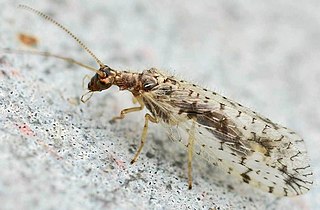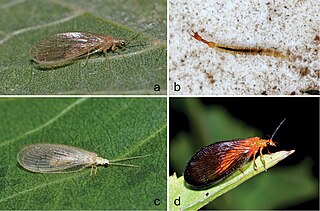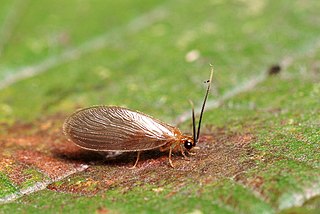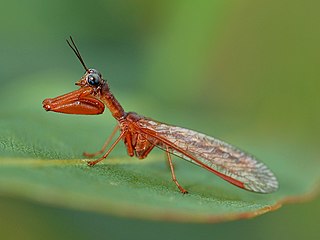| Neoconis | |
|---|---|
| Scientific classification | |
| Kingdom: | Animalia |
| Phylum: | Arthropoda |
| Class: | Insecta |
| Order: | Neuroptera |
| Family: | Coniopterygidae |
| Subfamily: | Aleuropteryginae |
| Genus: | Neoconis Enderlein, 1930 |
| Neoconis | |
|---|---|
| Scientific classification | |
| Kingdom: | Animalia |
| Phylum: | Arthropoda |
| Class: | Insecta |
| Order: | Neuroptera |
| Family: | Coniopterygidae |
| Subfamily: | Aleuropteryginae |
| Genus: | Neoconis Enderlein, 1930 |

The insect order Neuroptera, or net-winged insects, includes the lacewings, mantidflies, antlions, and their relatives. The order consists of some 6,000 species. Neuroptera can be grouped together with the Megaloptera and Raphidioptera in the unranked taxon Neuropterida including: alderflies, fishflies, dobsonflies, and snakeflies.

Mantispidae, known commonly as mantidflies, mantispids, mantid lacewings, mantisflies or mantis-flies, is a family of small to moderate-sized insects in the order Neuroptera. There are many genera with around 400 species worldwide, especially in the tropics and subtropics. Only 5 species of Mantispa occur in Europe. As their names suggest, members of the group possess raptorial forelimbs similar to those of praying mantis, a case of convergent evolution.

Hemerobiidae is a family of Neuropteran insects commonly known as brown lacewings, comprising about 500 species in 28 genera. Most are yellow to dark brown, but some species are green. They are small; most have forewings 4–10 mm long. These insects differ from the somewhat similar Chrysopidae not only by the usual coloring but also by the wing venation: hemerobiids differ from chrysopids in having numerous long veins and forked costal cross veins. Some genera are widespread, but most are restricted to a single biogeographical realm. Some species have reduced wings to the degree that they are flightless. Imagines (adults) of subfamily Drepanepteryginae mimic dead leaves. Hemerobiid larvae are usually less hairy than chrysopid larvae.

The Berothidae are a family of winged insects of the order Neuroptera. They are known commonly as the beaded lacewings. The family was first named by Anton Handlirsch in 1906.

The Nevrorthidae, often incorrectly spelled "Neurorthidae", are a small family of winged insects of the order Neuroptera. Extant species may be described as living fossils. There are 19 extant species in four genera, with a geographically disjunct distribution, Nevrorthus, comprising 5 species with scattered distributions around the Mediterranean, Austroneurorthus with two species known from southeastern Australia, Nipponeurorthus comprising 11 species known from China and Japan, and Sinoneurorthus known from a single species described from Yunnan Province, China. They were at one time placed in the Osmyloidea, with the Osmylidae and the spongillaflies (Sisyridae) as their closest relatives, but nowadays they are considered to be the most ancient lineage of living lacewings. Sometimes they are placed in a suborder Nevrorthiformia, but the quite basal position of the family is probably better expressed by placing them directly in the Neuroptera, without assigning the subordinal rank.

Psychopsidae is a family of winged insects of the order Neuroptera. They are commonly called silky lacewings.

Rhachiberothidae, sometimes called thorny lacewings, are a family of winged insects in the order Neuroptera. The family has only 14 extant species in 4 genera found in Sub-Saharan Africa, but has a diverse fossil record extending back to the Early Cretaceous in Lebanon, Eurasia and North America. Like the closely related Mantispidae members of the group possess raptorial forelegs, which probably only evolved once in the common ancestor of the groups.

Sisyridae, commonly known as spongeflies or spongillaflies, are a family of winged insects in the order Neuroptera. There are approximately 60 living species described, and several extinct species identified from the fossil record.

The dustywings, Coniopterygidae, are a family of Pterygota of the net-winged insect order (Neuroptera). About 460 living species are known. These tiny insects can usually be determined to genus with a hand lens according to their wing venation, but to distinguish species, examination of the genitals by microscope is usually necessary.

Alderflies are megalopteran insects of the family Sialidae. They are closely related to the dobsonflies and fishflies as well as to the prehistoric Euchauliodidae. All living alderflies – about 66 species all together – are part of the subfamily Sialinae, which contains between one and seven extant genera according to different scientists' views.

Chrysopinae is the nominate subfamily of green lacewings in the insect family Chrysopidae in the order Neuroptera. This subfamily is also the largest within the family and comprises about 60 genera.
Spiloconis is a genus of lacewing.
This list of fossil arthropods described in 2013 is a list of new taxa of trilobites, fossil insects, crustaceans, arachnids and other fossil arthropods of every kind that have been described during the year 2013. The list only includes taxa at the level of genus or species.
This list of fossil arthropods described in 2012 is a list of new taxa of trilobites, fossil insects, crustaceans, arachnids and other fossil arthropods of every kind that have been described during the year 2012. The list only includes taxa at the level of genus or species.

Chrysopini is a tribe of green lacewings in the family Chrysopidae. There are about 32 genera and 926 described species in Chrysopini.

Mantispinae is a subfamily of mantidflies in the family Mantispidae. There are at least 30 genera and 310 described species in Mantispinae.

Nusalala is a genus of brown lacewings. The scientific name was published in 1913 by Longinos Navás. They belong to the subfamily Microminae, as well as the genera Micromus and Megalomina.
Some species of this genus, such as Nusalala brachyptera, are "brachypter" meaning short wings, and have lost the ability to fly; they can only jump. This phenomenon has evolved in a number of genera in the family Hemerobiidae

Dicromantispa is a genus of mantidflies in the family Mantispidae. There are about 10 described species in Dicromantispa.
Burmese amber is fossil resin dating to the early Late Cretaceous Cenomanian age recovered from deposits in the Hukawng Valley of northern Myanmar. It is known for being one of the most diverse Cretaceous age amber paleobiotas, containing rich arthropod fossils, along with uncommon vertebrate fossils and even rare marine inclusions. A mostly complete list of all taxa described up until 2018 can be found in Ross 2018; its supplement Ross 2019b covers most of 2019.